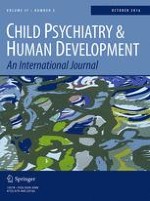10-12-2015 | Original Article
Paranoid Thoughts in Adolescents with Social Anxiety Disorder
Gepubliceerd in: Child Psychiatry & Human Development | Uitgave 5/2016
Log in om toegang te krijgenAbstract
Recently, social anxiety disorder (SAD) and paranoia have been demonstrated to be closely related. However, data were primarily drawn from adult community samples or patients with schizophrenia. The present study used a cross-sectional design to evaluate a sample of adolescents with SAD (n = 30, mean age 15.3 ± 0.9 years) compared with an age- and sex-matched group of healthy controls (n = 26, mean age 15.9 ± 1.6 years). The SAD group displayed more frequent and intense paranoid thoughts than the control group (t = 4.16, p < 0.001). The level of paranoid thoughts was significantly predicted by the degree of social phobia, even after adjusting for sex and other anxiety disorders, although adjusting for depression slightly reduced the extent and significance of the prediction. A lack of awareness about the association between SAD and paranoia may lead to incorrect diagnoses (e.g. misdiagnosis of psychotic disorders), or it may negatively influence the (psycho)therapeutic process and patient outcomes.
